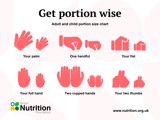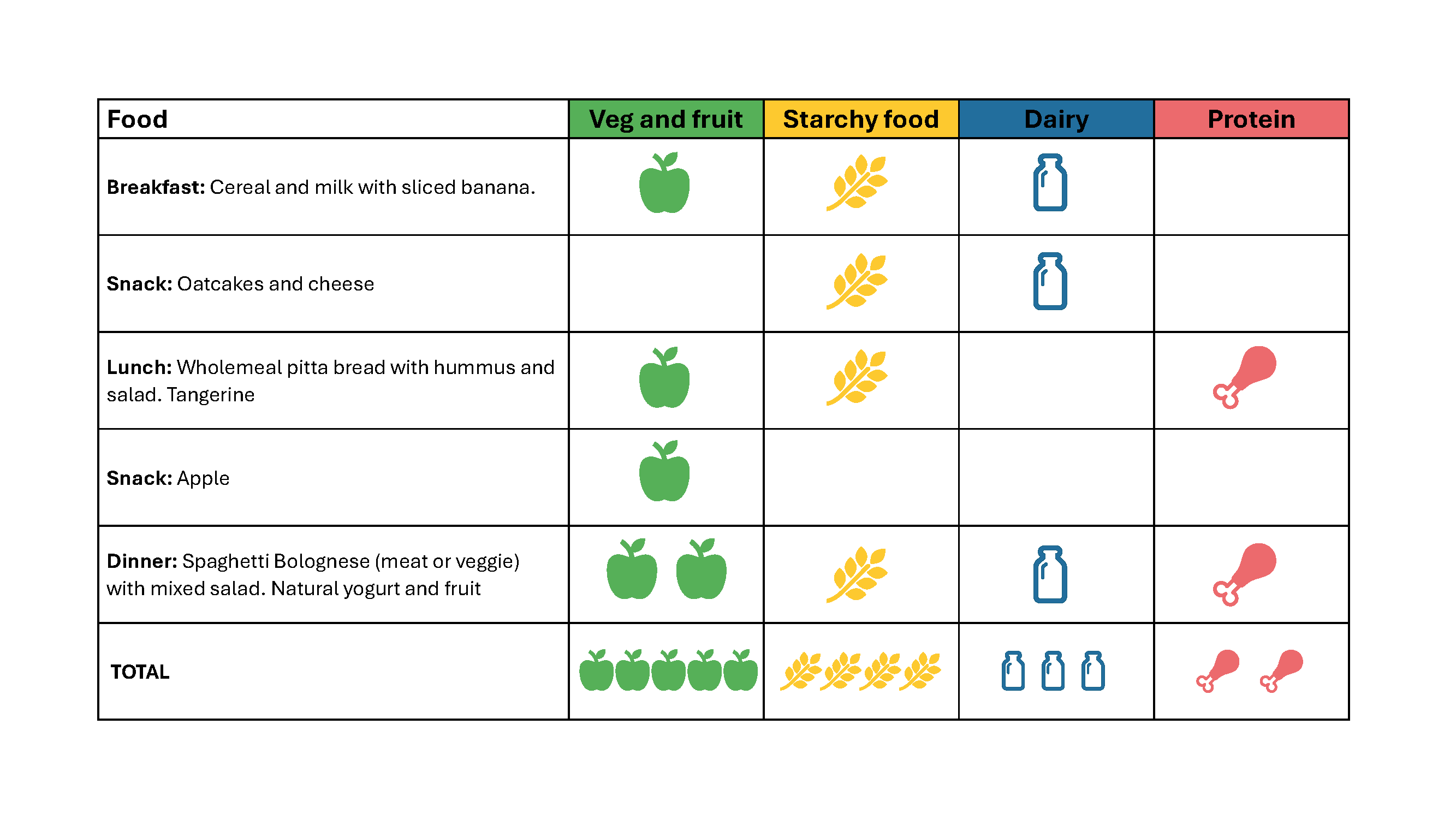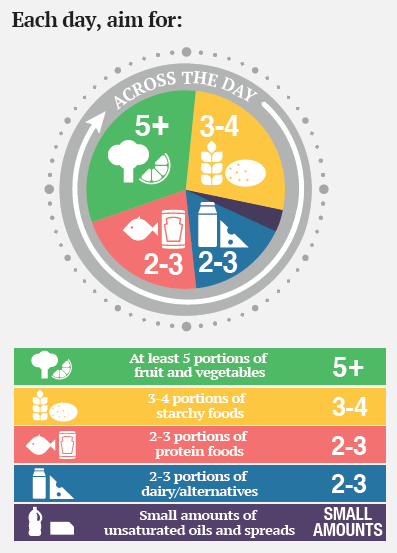Having a healthy, balanced diet is about how much as well as what we eat. Understanding what the right portion size is for ourselves, and our families can help us get the balance right.
The environment we live in makes it easy for us to eat too many calories. Many adults and children in the UK are living with overweight and obesity, which can harm health now and in the future. Controlling portion sizes is one way we can help ourselves eat the right amount and avoid weight gain.
Scientific studies show that when both children and adults are presented with bigger portions of food, they tend to eat more. So, when serving meals at home, or choosing ready-made or packaged foods, starting with a smaller portion can help us to avoid overeating.
When it comes to vegetables and fruit without added sugar, salt or fat, the key message is to eat more! Most vegetables and fruit are not high in calories and provide fibre and essential nutrients. So, include them at all mealtimes, have vegetables or fruit as snacks, and have fruit-based puddings.
Starchy foods such as bread and pasta, protein-rich foods like meat, fish, eggs and beans and dairy foods like yogurt and cheese are all nutritious parts of a balanced diet. But large portions can mean too many calories, so it’s important to be aware of portion sizes.
Foods high in fat, salt and sugar such as chocolate, biscuits, cakes, crisps and fried chips are not needed in the diet but many of us eat too many of them. If you do include these foods, keep the portion sizes small and don’t have them too often.
This page provides information on portion sizes for children and adults.
Portion sizes for children
All parents want to feed their children well and for them to grow up healthily. But our environment makes this difficult. Children’s food-related health, including childhood obesity, is a big concern*.
It’s important that children are offered appropriate portion sizes for their own age and size. Offering larger portions than children need encourages them to eat more, which can lead to weight gain over time.
Children, especially younger children, need smaller portion sizes than adults – below are some tips on finding the right portion sizes for your child as part of a healthy, balanced diet:

- Child-sized portions – serve children portions in proportion to their size. To get an idea you could compare their hand size to yours to get an idea of how their portion size should compare. For example, when serving out pasta or rice, serve out the amount that would fit in two hands cupped together for you and your child and see the difference. Some hand measures and portion size weights for children are shown below.
- Start small - start off with a smaller portion and see how your child feels. You can offer a second helping if they are still hungry. Use smaller plates and bowls for younger children to help keep portion sizes right for their size.
- No pressure – many parents want their children to ‘clear the plate’ but this is not helpful. Children need to be allowed to stop eating when full and learn to listen to their body’s appetite signals. To avoid wasting food, start with a small portion.
- Variety and balance – offer a variety and balance of different foods from the main food groups. Offer vegetables with midday and evening meals – these can be on the side or as part of dishes like pasta bakes, curries or stews. Offer fruit first for pudding.
- Smart snacks – healthier snacks can provide important nutrients as well as satisfying hunger or treat cravings. For example, an oat cake with soft cheese, a piece of fruit, vegetables sticks, a slice of wholemeal toast with peanut butter, or natural yogurt with raisins.
- Limit unhealthy treats - foods high in fat, salt and sugar like chocolate, sweets, fried crisps and biscuits, should be eaten in small portions (around 100 calories) and not often. Check the calorie content of packaged snacks on the label and don’t give adult sized portions of treat foods to children.
*[If you are worried about eating disorders or problems in children you can find out more from organisations such as https://www.youngminds.org.uk/ and https://www.beateatingdisorders.org.uk/]
Some portion size examples
If you would like to measure portion size accurately then the best way is to weigh out foods. This is extra effort, but it can give you a clear picture of the portion sizes that you and your children eat. Some examples of portion sizes in grams for children of different ages are given in the table below.
Hand measures can also give you a guide on portion sizes. This is not as accurate as weighing out food but can be a useful practical way to get an idea of a sensible portion size. You can see some other hand measures that can be used for adults in our portion size guides.
Portion size measures using your child's hands:
- Breakfast cereal (flakes, puffs etc) – about 3 medium handfuls
- Baked potato – about the size of their fist
- Dried pasta shapes/rice – about 2 handfuls
- Cooked pasta, rice, noodles – about the amount that would fit in two hands cupped together
- Cooked chicken breast or fish fillet – about the size of their hand
- Cooked red meat – about the size of their palm
- Hard cheese – about the size of two thumbs

Portion size weights for children of different ages
This table provides some portion sizes for children of different ages based on research by child health experts.
For many foods there is a portion size and a range (in brackets) to allow for children of different sizes, different amounts of physical activity and how quickly they are growing.
These were developed by looking at how the different food groups can be put together to provide all the energy and nutrients that children of different ages need. If you would like to weigh out some portion sizes for your children, you can use these as a guide. It’s not necessary to follow each portion exactly, but the portion size and range provided are a guide for appropriate portions at different ages.
Balancing the diet over a day
A healthy diet means getting a balance of foods from the main food groups over a day. Researchers suggest this should be:
- At least 5 portions of vegetables and fruit
- 4 portions of starchy foods
- 3 portions of dairy or plant-based alternatives
- 2 portions of protein foods
An example across the day:

A combination of balanced meals and healthy snacks provided in appropriate portions along with plenty of fruit and vegetables can provide children with the energy and nutrients needed to grow, learn and be healthy (note that vitamin D supplements are advised for both children and adults in autumn and winter – see our page on vitamins and minerals for more information). For more information see our page on nutrition for children.
The 5-5-3-2 portion guide - for toddlers and preschool
The 5-5-3-2 guide relates to amount of portions of each food group that children should be getting each day
Download the 5-5-3-2 portion guide
The 5-5-3-2 guide has portion size examples for a range of foods to give you an idea of what is appropriate to offer children. Children’s appetites can vary a lot so let them decide how much to eat.
Portion sizes for adults
For healthy adults, the types of different foods we need are similar for all of us but, the amount of food we need varies from person to person. Having a balance of foods from the main food groups in appropriate portions will help you get the right amount of calories and nutrients to provide for your needs. This can help keep you healthy and help you maintain a healthier weight.
Getting portion size right for you
We are all different and may need different portions depending on our age, height and weight and how active we are.
We have put together portion size guides that give suggested portion sizes for a range of different foods to help you find the right balance for you. These are based on an average calorie requirement of 2000kcal per day so you may need more or less than this.
The portion sizes are designed to fit with the balance of foods recommended in Government healthy eating advice. You can find out more in our page on a healthy, balanced diet.
Getting the balance right
Three key steps to getting the balance right for you:
- Know your food groups
- Get a balance from the main food groups across the day
- Check your portions
How do I measure portion sizes?
If you want to measure portion size accurately the best way is to weigh your food but that isn't always an easy option. Instead, we have provided some practical measures using your hands and spoons as a simple way to estimate sensible portion sizes.
The portion sizes we have given below are based on a daily calorie need of 2000kcal – the amount estimated for an average, healthy adult woman. If you’re tall or very active you may need more. If you’re a small person or are trying to lose weight, you may need smaller portions.
If you use the hand measures we have given below, portion sizes will vary with the size of your hands and so, generally, bigger people will get bigger portions and smaller people will get smaller portions.
What is a portion?
Practical examples of portion sizes
Dried pasta shapes or rice About two handfuls (75g)
Spaghetti A bunch the size of a £1 coin (75g)
A baked potato About the size of your fist (220g)
Breakfast cereal About three handfuls (40g)
Chicken breast About size of your whole hand (120g)
Cheddar cheese A piece about the size of two thumbs together (30g)
Peanut butter About one tablespoon (20g)
Soft cheese About three teaspoons (30g)
Suggested daily portions from each food group:
- Fruit and vegetables: 5+ portions per day
- Starchy carbohydrates: 3-4 portions per day
- Beans, pulses, fish, eggs, meat and other proteins: 2-3 portions per day
- Dairy and alternatives: 2-3 portions per day

Download our portion guides:
We hope these guides help you find your balance!
A healthy, balanced diet is about getting the right types of foods and drinks in the right amounts. These guides aim to help you find the right balance for you – it’s not only about how much you eat, it’s also about the types of foods you eat.











